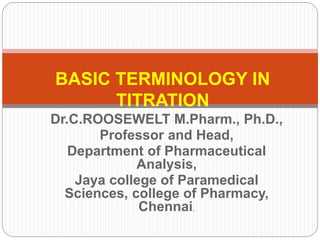
Basic terminology in titration
- 1. Dr.C.ROOSEWELT M.Pharm., Ph.D., Professor and Head, Department of Pharmaceutical Analysis, Jaya college of Paramedical Sciences, college of Pharmacy, Chennai. BASIC TERMINOLOGY IN TITRATION
- 3. BASIC TERMINOLOGY IN TITRATION TITRATION: A titration is a technique where a solution of known concentration is used to determine the concentration of an unknown solution. Typically, the titrant (the known solution) is added from a burette to a known quantity of the analyte/titrate (the unknown solution) until the reaction is complete. Knowing the volume of titrant added allows the determination of the concentration of the unknown. Often, an indicator is used to usually signal the end of the reaction, the endpoint
- 4. BASIC TERMINOLOGY IN TITRATION TITRANT: Titrant is a substance added from the burette. Titrant used and the reaction principle that proceeds usually defines name of the titration - like acid-base (or alkalimetric) titration if we use strong acid (or strong base) as a titrant, or redox when the reaction that proceeds is of a redox type. TITRATE/ ANALYTE Titrate is (analytical chemistry) to ascertain the amount of a constituent in a solution (or other mixture) by measuring the volume of a known concentration (the "standard solution") needed to complete a reaction. Analyte is a substance whose chemical constituents are being identified and measured.
- 5. BASIC TERMINOLOGY IN TITRATION INDICATOR: Indicator is a substance that changes color in response to a chemical change. An acid-base indicator (e.g., phenolphthalein) changes color depending on the pH. Redox indicators are also used. A drop of indicator solution is added to the titration at the beginning; the endpoint has been reached when the color changes.
- 6. BASIC TERMINOLOGY IN TITRATION EQUIVALENCE POINT: The equivalence point is the exact point in a titration when moles of one titrant equal the moles of the substance being titrated. ENDPOINT: The endpoint is the point where the system changes when the moles of the reacting titrant exceed the moles of the substance being titrated.
- 7. BASIC TERMINOLOGY IN TITRATION Difference between Equivalence Point and End Point? The equivalence point in a titration is the point at which the added titrant is chemically equivalent completely to the analyte in the sample. End point is the point where the indicator changes its color. Equivalence point comes before the end point.
- 8. BASIC TERMINOLOGY IN TITRATION STANDARDIZATION: Standardization is the process of determining the exact concentration (molarity) of a solution. Basically standardardization is carried to know the strength of the secondary standard prepared for carring out the assay. It is done to ensure the strength of secondary standard prepared. The strength calculated after standardization is used to calculate the content or percentage purity.
- 9. BASIC TERMINOLOGY IN TITRATION PRIMARY STANDARD: A primary standard is a reagent which is very pure, representative of the number of moles the substance contains and easily weighed. Primary standards are typically used in titration to determine an unknown concentration and in other analytical chemistry techniques. Primary standards are often used to make standard solutions. Properties of Primary Standards A good primary standard meets the following criteria: high level of purity low reactivity (high stability) high equivalent weight (to reduce error from mass measurements) not hygroscopic (to reduce changes in mass in humid versus dry environments) non-toxic inexpensive and readily available
- 10. BASIC TERMINOLOGY IN TITRATION SECONDARY STANDARD: A related term is "secondary standard". A secondary standard is a chemical that has been standardized against a primary standard for use in a specific analysis. Secondary standards are commonly used to calibrate analytical methods
- 11. BASIC TERMINOLOGY IN TITRATION DRUG: Drug is a Natural or synthetic substance which (when taken into a living body) affects its functioning or structure, and is used in the diagnosis, mitigation, treatment, or prevention of a disease or relief of discomfort. ASSAY : An assay is a test of a substance to find out what chemicals it contains. It is usually carried out to find out how pure a substance is.
- 12. BASIC TERMINOLOGY IN TITRATION METHODS OF EXPRESSING CONCENTRATION: 1. Normality 2. Molarity 3. Molality 4. Percent Solution 5. Formal Concentration 6. Parts per Million (PPM)
- 13. BASIC TERMINOLOGY IN TITRATION Normality- Normality is the number of gram equivalent of solute (Substance) dissolved in one litre (1000 ml) of solution. Normality is indicated by N
- 14. BASIC TERMINOLOGY IN TITRATION MOLARITY: Molarity is the number of moles of solute (Substance) dissolved in one litre (1000 mL) of Solution. Molarity is indicated by M Number of moles of Solute M = ------------------------------------ 1000 mL of Solution
- 15. BASIC TERMINOLOGY IN TITRATION MOLALITY: Molality is a molal solution contains1 mole of solute per one kilogram of solution. Molality is indicated by m Number of mol. Wt. of substance m = --------------------------------------- 1000 gm of Solution (1Kg)
- 16. BASIC TERMINOLOGY IN TITRATION Percent (%) Solution The concentration is expressed in terms of per cent (parts per hundred) also. Per cent Composition of a solution can be expressed as: 1. Per cent W/W = Weight of solute/ Weight of solution X100 2. Per cent V/V =Volume of solute/ Volume of solution X 100 3. Per cent W/V= Weight of solute/ Volume of solution X100
- 17. BASIC TERMINOLOGY IN TITRATION Parts Per Million Parts per million is frequently employed to express the concentration of very dilute solutions and is express as PPM
- 18. Thank you
